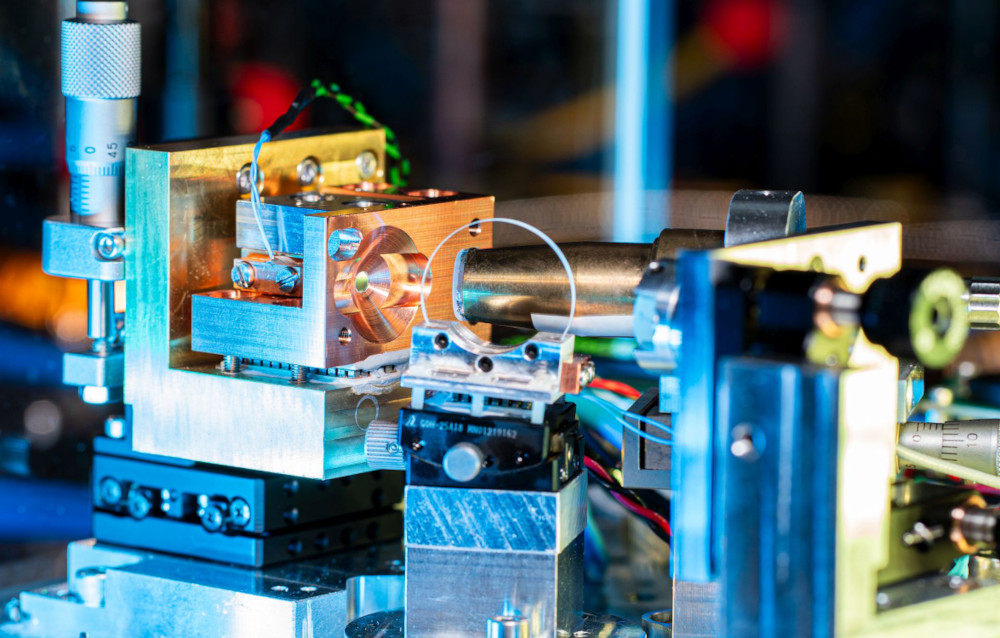
09 Apr Qubits: With matching frequency into the optical fibre
The quantum internet could one day help to fully utilise the potential of certain technologies. These include much more powerful quantum computing through the linking of quantum processors and registers, more secure communication through quantum key distribution or more precise time measurements through the synchronisation of atomic clocks.
However, the differences between the glass fibre standard of 1550 nm and the system wavelengths of the various quantum bits (qubits) realised to date, which are mostly in the visible or near-infrared spectral range, represent a hurdle on the way. Researchers want to overcome these hurdles with the help of quantum frequency conversion, which can specifically change the frequencies of photons while retaining all other quantum properties. The aim is to convert to the 1550 nm telecom range for low-loss, long-range transmission of quantum states.
Disc laser for frequency conversion
In the joint project ‘HiFi – Highly integrated quantum frequency converter of highest fidelity based on innovative laser, fibre and production technology’ funded by the German Federal Ministry of Education and Research (BMBF), researchers are therefore working on all the necessary technologies to provide quantum frequency converters (QFK) with high efficiency and low noise for initial test tracks. The Fraunhofer Institute for Applied Solid State Physics IAF has contributed to the project with the successful development of disc lasers (also known as vertical external-cavity surface-emitting lasers, VECSEL) based on gallium antimonide (GaSb). These are optically pumped, surface-emitting semiconductor lasers with an external resonator and intracavity filter for wavelength selection.
Qubit output wavelength between 1.9 and 2.5 µm
“The disc lasers we developed as part of ‘HiFi’ are spectrally narrow-band pump sources that cover a wavelength between 1.9 and 2.5 µm, depending on the output wavelength of the qubits used, and achieve up to 2.4 W output power with an absolute wavelength stability of less than 2 fm,” explains Dr Marcel Rattunde, sub-project coordinator and head of the Optoelectronics department at Fraunhofer IAF.
“This corresponds to a frequency stability of less than 100 kHz and clearly falls below the frequency stability class 1-9. This result represents an international best value for this type of laser.” According to the researcher, the result was made possible by the close cooperation with project partner Menlo Systems. “Together, we locked the disc laser to a frequency comb, which in turn was coupled to a 10 MHz reference.”
During their experiments, the researchers set the emission wavelength exactly to the target wavelength of 2062.40 nm for demonstration experiments at the fibre link of Saarland University, to which Fraunhofer IAF has since handed over the laser module, according to the researchers. In addition to power scaling, the precise understanding of the mode behaviour of the lasers and the identification and elimination of noise sources are the most important research tasks of the Fraunhofer IAF in the HiFi project.

Disc laser setup for the development of a low-noise pump source for quantum frequency conversion. Image: Fraunhofer IAF
Pump laser fulfils high requirements
In quantum frequency conversion, the energy of the pump photon is subtracted from the signal photon by a difference frequency process in a non-linear optical crystal. To ensure a low-noise process, the energy of the pump photons must be below the target wavelength (usually 1550 nm), otherwise the pump laser can generate photons in the output signal due to parasitic effects.
In combination with Menlo’s frequency comb, the disc lasers developed at Fraunhofer IAF meet the high requirements of quantum frequency conversion, as their narrow bandwidth and wavelength stability prevent fluctuations in the pump wavelength and consequently changes in the target wavelength of the qubits. If there is a deviation above the natural linewidth, the qubits would no longer be indistinguishable, which would remove a basic requirement for subsequent quantum mechanical processing.
Source and image: https://www.iaf.fraunhofer.de/






